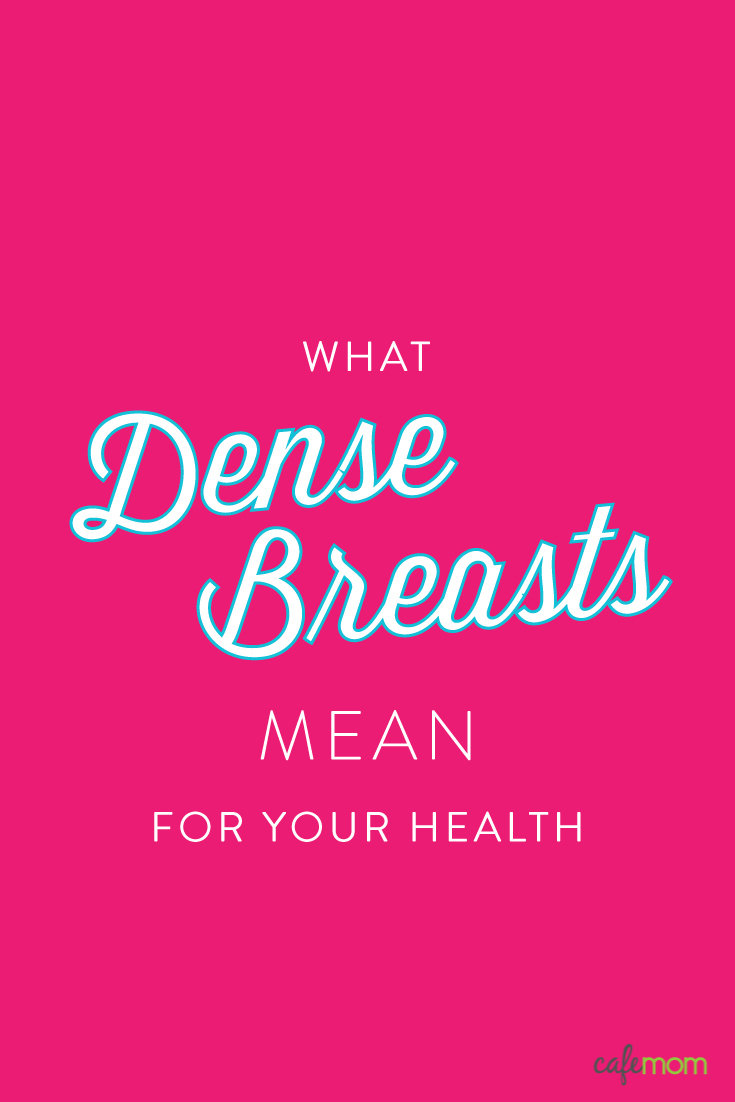“Dense breasts” is NOT a description of how your breasts feel. And it’s not a judgy comment. It refers to how dense your breast tissue appears on a mammogram, “which is a reflection of how difficult it might be to pick up an abnormality,” explains Maggie DiNome, MD, associate director of the Margie Petersen Breast Center at John Wayne Cancer Institute at Providence Saint John’s Health Center in Santa Monica, California.
Dense breast tissue shows up as white on a mammogram. As do small, invasive cancers. “So you can imagine that it might be difficult to spot a small cancer in the background of dense breasts — like trying to find a polar bear in a snowstorm,” Dr. DiNome says. And not just that, but dense breast tissue also independently increases your risk of breast cancer. So what should you do if someone’s told you that YOU’VE got dense breasts? For starters: Don’t panic. “Dense breasts are normal and most women [who have them] will never be diagnosed with breast cancer,” reassures Richard Reitherman, MD, PhD, medical director of breast imaging at MemorialCare Breast Center at Orange Coast Memorial Medical Center in Fountain Valley, California. More from The Stir: Having My First Mammogram Was the Wake-Up Call I Needed But you still may want to talk to your OB/GYN about referring you for an ultrasound or 3D imaging along with your mammogram. “A recent study showed that both increase the ability to detect breast cancer over standard mammogram alone,” Dr. DiNome explains. Great, you might be thinking. Exposure to even MORE radiation. But that’s not the case, according to Dr. DiNome. Although radiation used to be a cause of concern with 3D imaging, “now the exposure is equally low [to a standard mammogram],” she says, “which amounts to the level of radiation someone gets just by living on planet earth for 7 weeks.” If you’re at high risk for breast cancer, a screening ultrasound may be the way to go. And for women with a high lifetime risk, a breast MRI is recommended. Still, none of this technology should sub out a mammogram. “Although mammograms lose sensitivity in women with dense breasts … it is still the only screening tool that’s been shown to reduce deaths from breast cancer,” says Dr. DiNome, “and the only screening tool that will likely detect abnormal calcifications which can be the first sign of an early breast cancer.” So now that you know what’s best for dense breasts, here comes the bad news. And yes, it has to do with health insurance, which is pretty much the most screwed-up system in America. Although your doctor may recommend you get one of these additional screenings, not every state requires health insurers to pay for them. “Patients end [up] having to decide whether the extra screening test is worth the out-of-pocket costs,” says Dr. DiNome. “It’s a difficult choice.” Image via thailoei92/Shutterstock



title: “What Every Woman With Dense Breasts Needs To Know” ShowToc: true date: “2024-09-13” author: “Jason Doane”
“Dense breasts” is NOT a description of how your breasts feel. And it’s not a judgy comment. It refers to how dense your breast tissue appears on a mammogram, “which is a reflection of how difficult it might be to pick up an abnormality,” explains Maggie DiNome, MD, associate director of the Margie Petersen Breast Center at John Wayne Cancer Institute at Providence Saint John’s Health Center in Santa Monica, California.
Dense breast tissue shows up as white on a mammogram. As do small, invasive cancers. “So you can imagine that it might be difficult to spot a small cancer in the background of dense breasts — like trying to find a polar bear in a snowstorm,” Dr. DiNome says. And not just that, but dense breast tissue also independently increases your risk of breast cancer. So what should you do if someone’s told you that YOU’VE got dense breasts? For starters: Don’t panic. “Dense breasts are normal and most women [who have them] will never be diagnosed with breast cancer,” reassures Richard Reitherman, MD, PhD, medical director of breast imaging at MemorialCare Breast Center at Orange Coast Memorial Medical Center in Fountain Valley, California. More from The Stir: Having My First Mammogram Was the Wake-Up Call I Needed But you still may want to talk to your OB/GYN about referring you for an ultrasound or 3D imaging along with your mammogram. “A recent study showed that both increase the ability to detect breast cancer over standard mammogram alone,” Dr. DiNome explains. Great, you might be thinking. Exposure to even MORE radiation. But that’s not the case, according to Dr. DiNome. Although radiation used to be a cause of concern with 3D imaging, “now the exposure is equally low [to a standard mammogram],” she says, “which amounts to the level of radiation someone gets just by living on planet earth for 7 weeks.” If you’re at high risk for breast cancer, a screening ultrasound may be the way to go. And for women with a high lifetime risk, a breast MRI is recommended. Still, none of this technology should sub out a mammogram. “Although mammograms lose sensitivity in women with dense breasts … it is still the only screening tool that’s been shown to reduce deaths from breast cancer,” says Dr. DiNome, “and the only screening tool that will likely detect abnormal calcifications which can be the first sign of an early breast cancer.” So now that you know what’s best for dense breasts, here comes the bad news. And yes, it has to do with health insurance, which is pretty much the most screwed-up system in America. Although your doctor may recommend you get one of these additional screenings, not every state requires health insurers to pay for them. “Patients end [up] having to decide whether the extra screening test is worth the out-of-pocket costs,” says Dr. DiNome. “It’s a difficult choice.” Image via thailoei92/Shutterstock



title: “What Every Woman With Dense Breasts Needs To Know” ShowToc: true date: “2024-10-10” author: “Phillip Walker”
“Dense breasts” is NOT a description of how your breasts feel. And it’s not a judgy comment. It refers to how dense your breast tissue appears on a mammogram, “which is a reflection of how difficult it might be to pick up an abnormality,” explains Maggie DiNome, MD, associate director of the Margie Petersen Breast Center at John Wayne Cancer Institute at Providence Saint John’s Health Center in Santa Monica, California.
Dense breast tissue shows up as white on a mammogram. As do small, invasive cancers. “So you can imagine that it might be difficult to spot a small cancer in the background of dense breasts — like trying to find a polar bear in a snowstorm,” Dr. DiNome says. And not just that, but dense breast tissue also independently increases your risk of breast cancer. So what should you do if someone’s told you that YOU’VE got dense breasts? For starters: Don’t panic. “Dense breasts are normal and most women [who have them] will never be diagnosed with breast cancer,” reassures Richard Reitherman, MD, PhD, medical director of breast imaging at MemorialCare Breast Center at Orange Coast Memorial Medical Center in Fountain Valley, California. More from The Stir: Having My First Mammogram Was the Wake-Up Call I Needed But you still may want to talk to your OB/GYN about referring you for an ultrasound or 3D imaging along with your mammogram. “A recent study showed that both increase the ability to detect breast cancer over standard mammogram alone,” Dr. DiNome explains. Great, you might be thinking. Exposure to even MORE radiation. But that’s not the case, according to Dr. DiNome. Although radiation used to be a cause of concern with 3D imaging, “now the exposure is equally low [to a standard mammogram],” she says, “which amounts to the level of radiation someone gets just by living on planet earth for 7 weeks.” If you’re at high risk for breast cancer, a screening ultrasound may be the way to go. And for women with a high lifetime risk, a breast MRI is recommended. Still, none of this technology should sub out a mammogram. “Although mammograms lose sensitivity in women with dense breasts … it is still the only screening tool that’s been shown to reduce deaths from breast cancer,” says Dr. DiNome, “and the only screening tool that will likely detect abnormal calcifications which can be the first sign of an early breast cancer.” So now that you know what’s best for dense breasts, here comes the bad news. And yes, it has to do with health insurance, which is pretty much the most screwed-up system in America. Although your doctor may recommend you get one of these additional screenings, not every state requires health insurers to pay for them. “Patients end [up] having to decide whether the extra screening test is worth the out-of-pocket costs,” says Dr. DiNome. “It’s a difficult choice.” Image via thailoei92/Shutterstock



title: “What Every Woman With Dense Breasts Needs To Know” ShowToc: true date: “2024-10-15” author: “Marian Collins”
“Dense breasts” is NOT a description of how your breasts feel. And it’s not a judgy comment. It refers to how dense your breast tissue appears on a mammogram, “which is a reflection of how difficult it might be to pick up an abnormality,” explains Maggie DiNome, MD, associate director of the Margie Petersen Breast Center at John Wayne Cancer Institute at Providence Saint John’s Health Center in Santa Monica, California.
Dense breast tissue shows up as white on a mammogram. As do small, invasive cancers. “So you can imagine that it might be difficult to spot a small cancer in the background of dense breasts — like trying to find a polar bear in a snowstorm,” Dr. DiNome says. And not just that, but dense breast tissue also independently increases your risk of breast cancer. So what should you do if someone’s told you that YOU’VE got dense breasts? For starters: Don’t panic. “Dense breasts are normal and most women [who have them] will never be diagnosed with breast cancer,” reassures Richard Reitherman, MD, PhD, medical director of breast imaging at MemorialCare Breast Center at Orange Coast Memorial Medical Center in Fountain Valley, California. More from The Stir: Having My First Mammogram Was the Wake-Up Call I Needed But you still may want to talk to your OB/GYN about referring you for an ultrasound or 3D imaging along with your mammogram. “A recent study showed that both increase the ability to detect breast cancer over standard mammogram alone,” Dr. DiNome explains. Great, you might be thinking. Exposure to even MORE radiation. But that’s not the case, according to Dr. DiNome. Although radiation used to be a cause of concern with 3D imaging, “now the exposure is equally low [to a standard mammogram],” she says, “which amounts to the level of radiation someone gets just by living on planet earth for 7 weeks.” If you’re at high risk for breast cancer, a screening ultrasound may be the way to go. And for women with a high lifetime risk, a breast MRI is recommended. Still, none of this technology should sub out a mammogram. “Although mammograms lose sensitivity in women with dense breasts … it is still the only screening tool that’s been shown to reduce deaths from breast cancer,” says Dr. DiNome, “and the only screening tool that will likely detect abnormal calcifications which can be the first sign of an early breast cancer.” So now that you know what’s best for dense breasts, here comes the bad news. And yes, it has to do with health insurance, which is pretty much the most screwed-up system in America. Although your doctor may recommend you get one of these additional screenings, not every state requires health insurers to pay for them. “Patients end [up] having to decide whether the extra screening test is worth the out-of-pocket costs,” says Dr. DiNome. “It’s a difficult choice.” Image via thailoei92/Shutterstock


